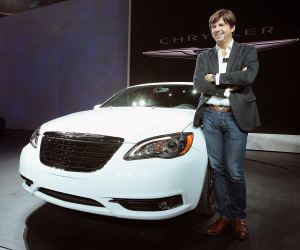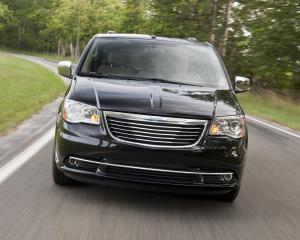By Roger Witherspoon
The Frenchman sat at a small corner table off to the side of the bustling, glittering, Chrysler-Fiat exhibit, speaking softly to associates and watching the coming-out party for his new company.
Last year, in the throes of bankruptcy and a shotgun wedding between the struggling Detroit auto maker and the glittering Italian company best known for its Ferrari and Maserati brands, Chrysler had skipped the big New York International Auto Show in the massive Jacob Javits Convention Center. Instead, Olivier Francois, the newly designated head of the merged company, had launched a crash redesign of all the cars in its Chrysler, Dodge, Ram, and Jeep lineup, while preparing an American version of its compact, European Fiat 500. A redesign process that normally takes about five years was crashed into 18 months
 In 2010 Chrysler was a New York Auto No-Show. But the revamped company’s party this year is lavish. The workhorse Jeep Wrangler got a facelift and rolled up and down a makeshift mountain wedged between the front of the convention center and the six lanes of taxis racing up and down 11th Avenue. Inside, the company’s muscle cars – the 392-horsepower Dodge Challenger and the wide-mouthed, 465-horsepower Charger SRT-8 – flanked the 150-mile-per-hour Jeep Grand Cherokee, whose refined Italian interior décor and 900-watt sound system would let you lose your license in style.
In 2010 Chrysler was a New York Auto No-Show. But the revamped company’s party this year is lavish. The workhorse Jeep Wrangler got a facelift and rolled up and down a makeshift mountain wedged between the front of the convention center and the six lanes of taxis racing up and down 11th Avenue. Inside, the company’s muscle cars – the 392-horsepower Dodge Challenger and the wide-mouthed, 465-horsepower Charger SRT-8 – flanked the 150-mile-per-hour Jeep Grand Cherokee, whose refined Italian interior décor and 900-watt sound system would let you lose your license in style.
The elegant but ageing Chrysler 300 sedan got an overdue facelift, and the ungainly, bottom-heavy, Chrysler Seabring got a sleek redesign and a new name, the Chrysler 200.
But everything looks shiny, new and inviting at an auto show and Chrysler-Fiat is making a splash just by showing up – and doing it in style. Francois was watching the crowds, scanning for that spark of excitement that would tell him the company was really back from the disastrous decisions of the semi-competent, cost cutting management which drove the company to the brink of collapse.
“In Europe,” said Francois, “we always considered Chrysler the best American brand. But it became a brand that was discontented and it had low brand loyalty. It’s as if you looked at your kid and said he was a low achiever and then started cutting costs – you don’t pay for the best clothes or the most expensive school and so on. If you have low expectations, then that’s what you get.
“Chrysler always had a very good image in Europe. It was considered very innovative and, actually less American. It was seen as exotic. It had stylistic cars. But you needed to put money and investment in the materials, and quality, and in its people. What matters most to buyers is not whether it’s a Dodge or Jeep or Ram Truck. The perceived quality of the cars was unsatisfactory.”
Dealer surveys and stories in Consumer Reports made it clear to Francois and his incoming team that cost cutting and bad management had led to the impression of cars with cheap materials, mediocre interior designs and excessive noise. And that realization, he said, came as a relief. Chrysler had talented people and a sound product lineup: It would not be necessary to scrap everything and start over.
Instead, what Chrysler needed was a “heavy tweak” in which they devoted attention to physical problems like materials, uneven suspension, and excess noise. All of the interiors were redesigned using better quality materials. These were corrections, said Francois, “that you can do relatively quickly.”
Francois avoided a culture clash in design by keeping all of Chrysler styling in the hands of Ralph Gilles, an African American, with input from the Italian design shop. The exception, however, is the introduction of the new Fiat 500, where Gilles plays a subordinate design role to the Italian team.
The Fiat 500 is another matter. The brand disappeared from the US more than 20 years ago because its poorly built cars didn’t sell. Now they are back, and convincing the public to get behind the wheel of the sporty little convertible is the chosen chore of Laura Soave, the sharp-eyed car exec who on the convention floor is easily mistaken for one of the svelte models adorning the showroom.
Soave left a post as general manager at Volkswagen, USA to head the reintroduction of Italian car. “It’s a once in a lifetime opportunity for me,” said Soave. “I’m a first generation American and a kid from Detroit who grew up with cars. My parents are both from Italy, and came here separately in their teens and met in Detroit.
“And I have a personal vision of what this brand can mean to Americans. I know how to blend the Italian culture and American culture very well.”
The cultural blend started at Fiat. Her promotion to CEO of Fiat’s American subsidiary makes the 39-year-old Soave the only female chief executive in the Italian car company, and one of the few top women in the American automotive industry. “What makes Fiat, USA unique,” she said, “is that we are an Italian design company, not an American company with an Italian label. When people think of Italian cars they think of the higher end of Fiat – Ferrari and Maserati and Lancia. And American consumers are in love with Italian things, like shoes and clothes and food. Now they can have that Italian flair in transportation.
“We don’t want our car to blend in with the rest of the small cars in the place. The small car market has always been a compromise, an affordability issue where you made tradeoffs in style, content, and safety. We’re not compromising, and will bring you all that great stuff in a perfect, small package.”
That’s a tall order, even for an ambitious, car-savvy Kid from Detroit. In recent years, several companies have turned their sights on the market for cars costing $20,000 or less. For years, this market was considered an after-thought, where scaled down vehicles were sold to young entry level, or low-income buyers. But now it is treated as a desirable segment of the market, and competition is heating up.
The 33 MPG Mazda 2, which looks remarkably like the equally small Toyota Yaris, goes head to head with the trend-setting Ford Fiesta and Nissan’s little Versa, to name a few small cars with very sharp automotive elbows. The design of the Fiat 500 lies somewhere between the venerable VW Beetle and the Mazda 2, with the same type of rolling soft-top found in the Smart-for-Two convertible. Breaking into this contentious turf will not be easy.
But Soave, now living and working out of the Detroit suburb of Auburn Hills, is not perturbed. She has the typical auto swagger of Motor City residents and is relishing the fact that Fiat gave her the chance to go home again.
“My parents think this is just great,” she said, beaming. “When they saw the announcement in the paper they cut it out and I made it onto their frig along with the pictures of the grandchildren. That was a pretty good moment.”




